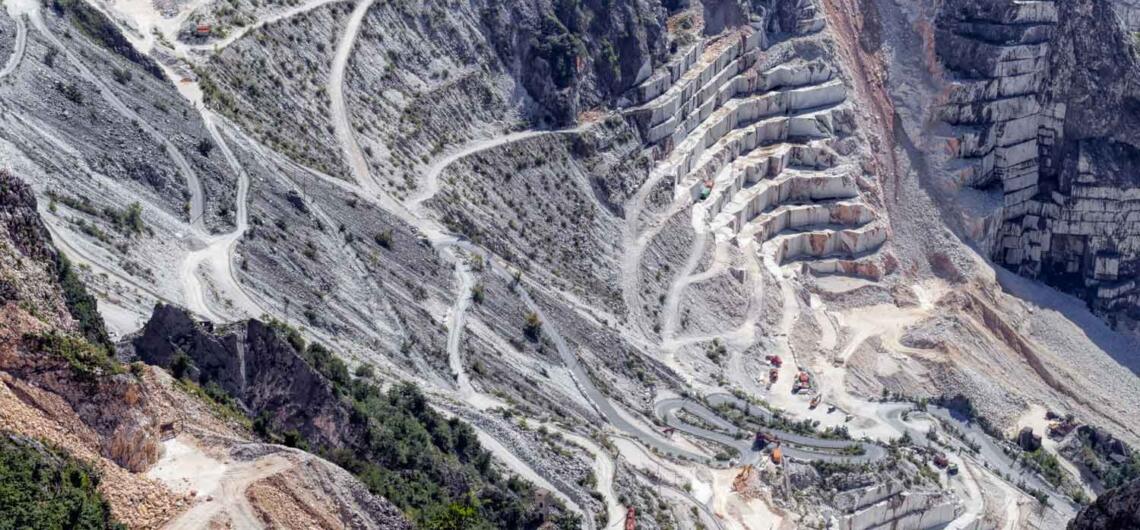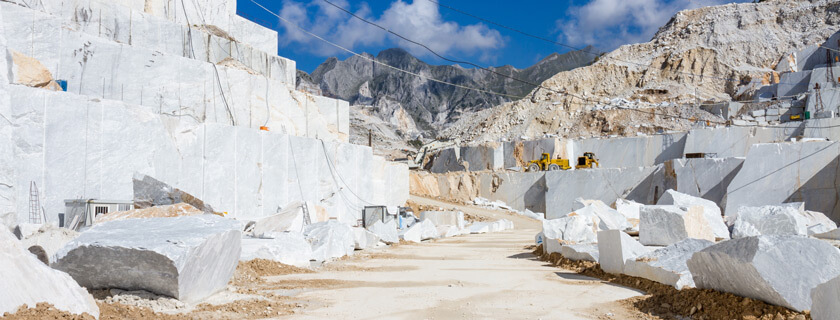Many are the reasons why Tuscany attracts thousands of visitors every year. Among them, you find the many different landscapes at short distance from each other: the Val d’Orcia with its round hills, romantic cypress trees and medieval hamlets; the lunar looking Crete Senesi with its dry clay hills near Siena; the beautiful coastline and the Tuscan archipelago; the typical countryside and the ancient vineyards and cellars.
However, in this article we would like to tell you about another very suggestive place in the north-west of Tuscany: the Apuan Alps. Locals like to call them marble mountains. This is where the famous Carrara marble comes from.
Read more to discover the well known marble quarries of Carrara on the Apuan Alps.
Visit the Marble Caves on the Apuan Alps with Us
If you wish to visit the magic Carrara marble caves and the suggestive Apuan Alps territory, you are in the right place. We organize private tours to the caves on adventurous off-road vehicles like the Carrara Marble Quarries Tour, with a taste of delicious Lardo di Colonnata included. We also have tours to the Apuan Alps and Garfagnana to discover not only the marble quarries of Carrara on the Apuan Alps but also the historical villages of Isola Santa and Barga. Remember that it is always possible to personalize the tour according to your wishes and to your needs.
Do not hesitate to contact us for more details.
The Marble Mountains in Tuscany
The Apuan Alps are located in the north-west of Tuscany between Lunigiana, Garfagnana and the Versilia Coast. This location makes it a very suggestive chain, only few kilometers far from the sea. The highest peak is the Mount Pisanino (1,947 m.). Locals usually call them marble mountains for the big concentration of this material in the area. Indeed the world-wide famous Carrara marble comes from these mountains and has been used over the centuries to produce great sculptures, elegant columns, coverings and floors. The white deposits on the mountains are visible in the distance and many often think the Apuan Alps are covered in snow. But it is only marble.
The chain extends for about 1000 km². Compared to the neighboring Appennines, the Apuan Alps look harsher and present steeper slopes. The name Apuan comes from the indigenous ligurian population living in the area before the Roman conquest. Part of this territory belongs to the regional Park (Parco naturale regionale delle Alpi Apuane) since 1985. The combination of harsh and steep slopes, marble baisins and underground cavities together with the proximity to the sea makes this landscape unique.
Here you can find approximatly 170 marble caves, that actually covers only 5% of the total area. The rest of it is made of forests, meadows, caves and pinnacles.
What is Carrara Marble

The Marble Caves of the Apuan Alps and the Marble Industry
The Apuan Alps host the biggest marble concentration in the world. The biggest baisins are located close to the town of Carrara. This precious material has been taken from those basins for more than 2000 years. Probably extractions started already during the Copper Age and gave birth to commemorative and decorative objects. Thanks to the many caves, to the professional skills and advanced technologies developed in the centuries, this area is today a leader in the marble market. The port of Marina di Carrara is very important to the industry. Marble is shipped and exported abroad. However, the presence of really specialized companies in the marble manufacturing makes it possible for foreign businessmen to have their marble blocks worked from the local experts in Carrara and then export it everywhere.
Once all the work was by hand. Bringing the enormous blocks of marble down the slope was one of the most dangerous jobs. Workers used the help of sleighs. During the 18th century the use of explosive made it easier to get the marble from the caves. However, people immediatly realized that after the explosion most of the material was useless because of the crashing. The result of these harsh extractions is still visible today in the big white spots on the mountains that look like snow.
Today we have big machineries cutting the marble blocks in sheets and polish them. When exploring the area, it is still possible to see the old railway lines connecting the three main baisins: Torano, Fantiscritti and Colonnata.
Several itineraries can help you discover the mountains of Carrara, from the one more related to extractions to the most naturalistic one. There are both open air caves and galleries from where you can admire a very suggestive landscape.
Enjoy the Colonnata lard from the Marble Mountains
If you like food and you wish to try something typical, the village of Colonnata is worth a stop. The preparation of this special lard is strictly connected to marble. According to the tradition, the Colonnata lard ages at a cool temperature in local Carrara marble tubs. It is important to rubb them with garlic first. Then you add sea salt, ground black pepper, fresh rosemary spigs and garlic cloves. In addition, marble lids cover the tubs, that remain shut up to 10 months. So the lard can get its aromas. The Colonnata lard got the IGP certification (Indicazione Geografica Protetta – Indication of Geographic Protection) and the perfect way to taste it is on a warm slice of toasted bread.
The Marble of Carrara in the Art
Many Greek and Roman artists used the Carrara marble to create some of their best sculptures during the Classical Period. Among them we can mention Michelangelo, Canova and Moore. For example Michelangelo came here to personally chose the blocks he needed to carve his works. He carefully chose it according to the colour, the grain and the veining. Michelangelo carved the well known David statue in Florence using this marble. It is said that also the Pantheon in Rome together with the marvellous Trajan’s Column come from the Carrara marble.
The nearby village of Pietrasanta pays an important role as a marble art embassadeur of this area. In fact, locals also call it Little Athens for being the capital of marble processing. There you find a beautiful open air itinerary, the International Conteporary Scultpure Park. In Pietrasanta you can find museums, artesans’ atelier and marble monuments. Marble has been used to embellish many churches, squares and streets in town.



Comments